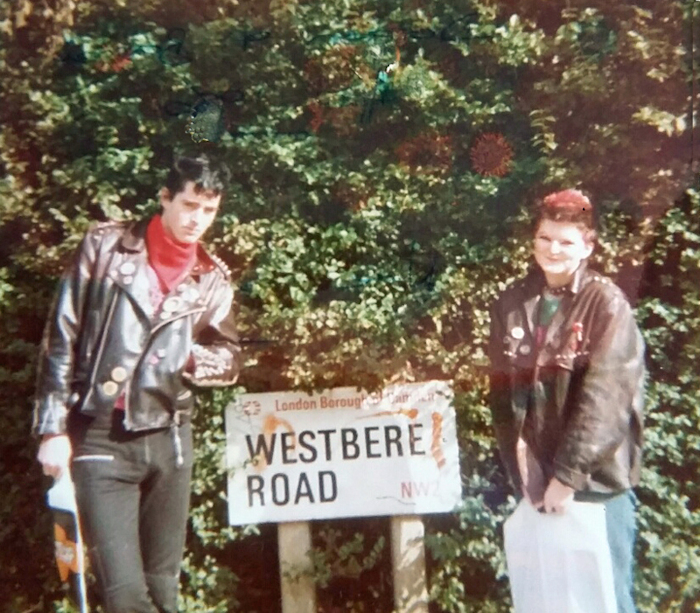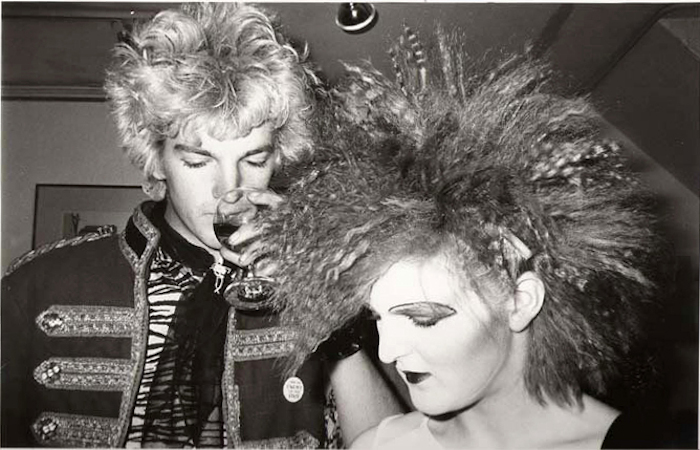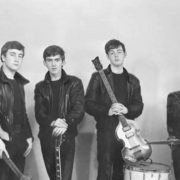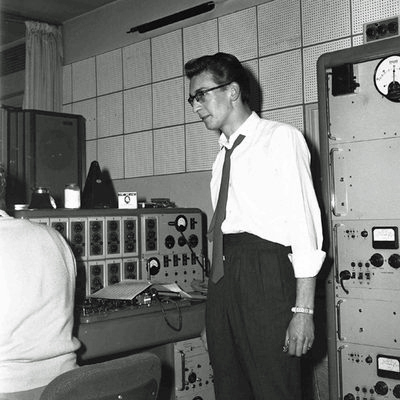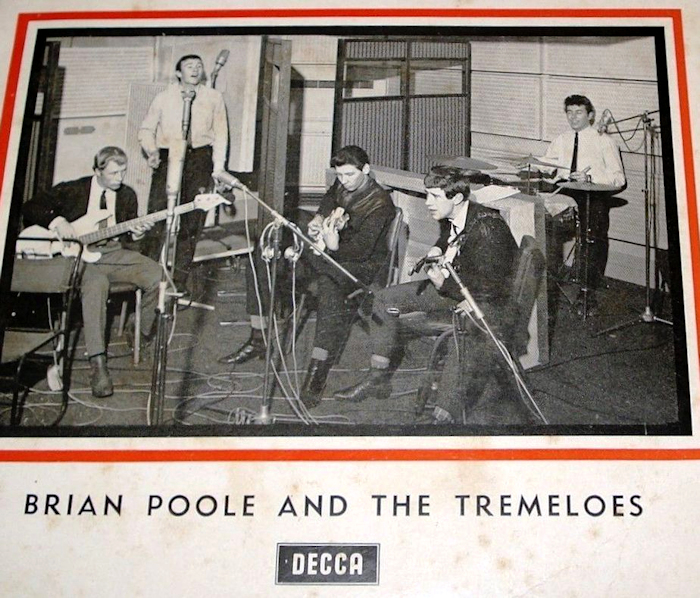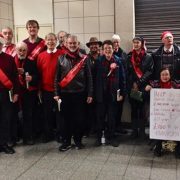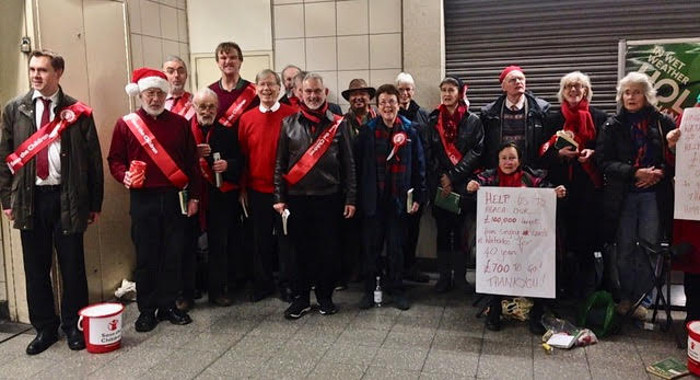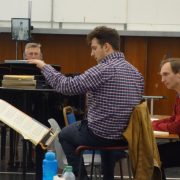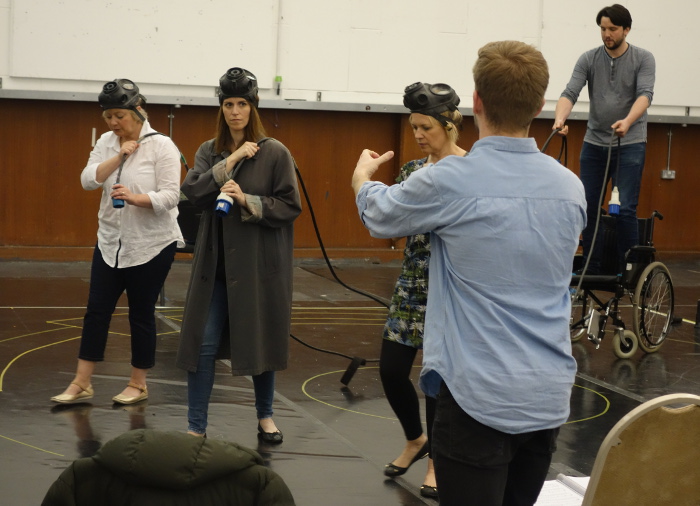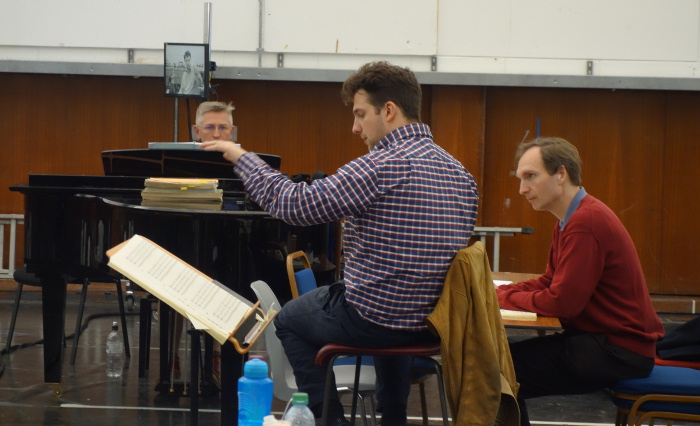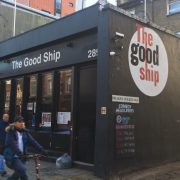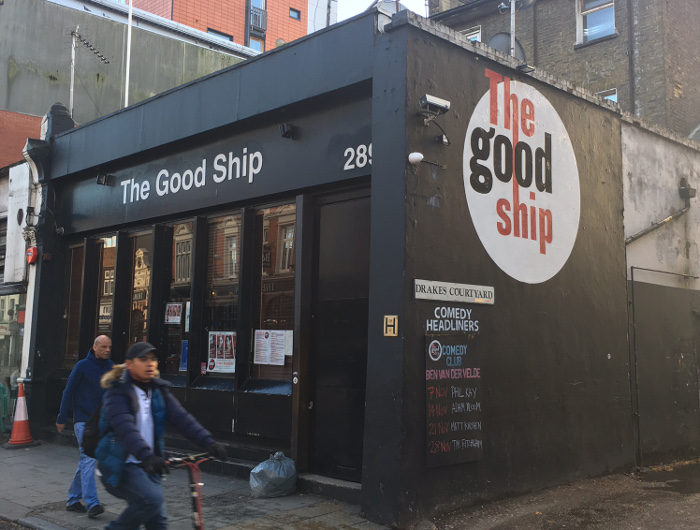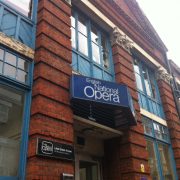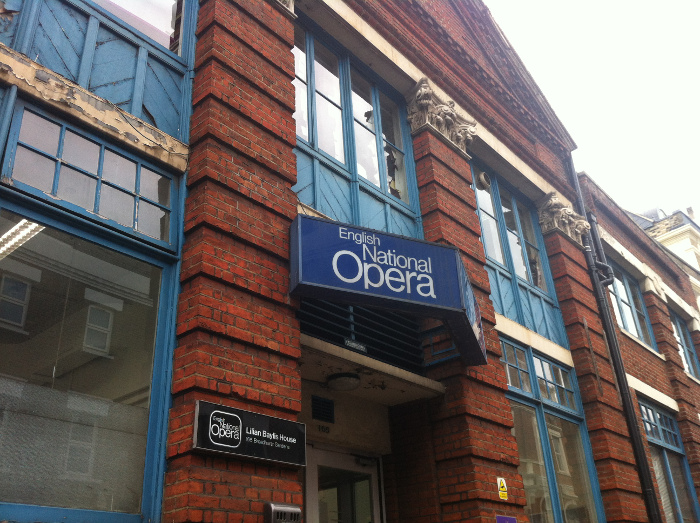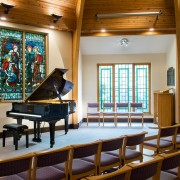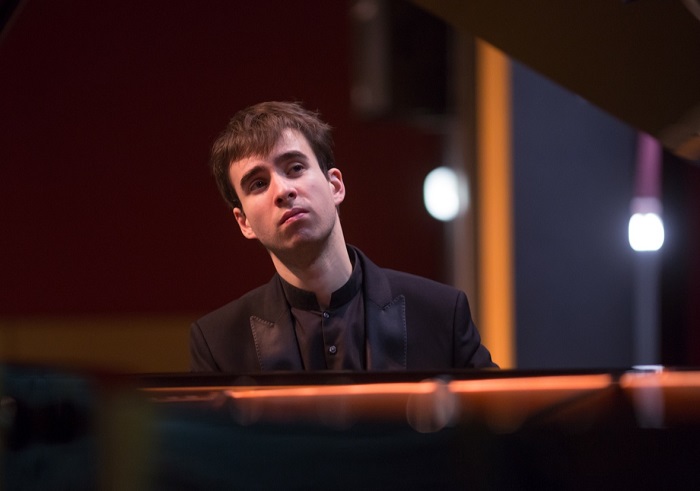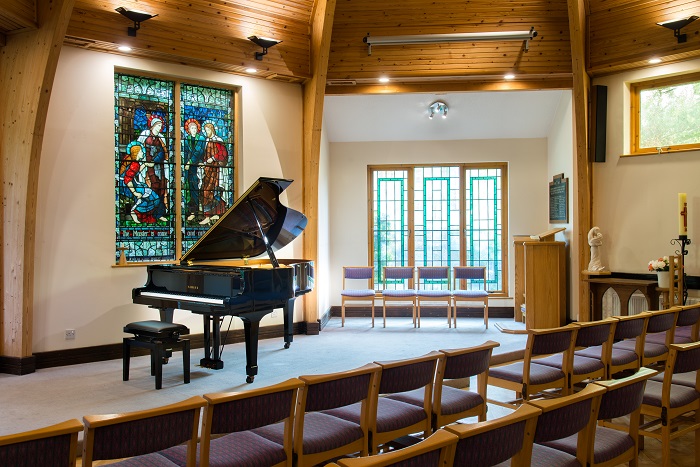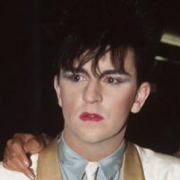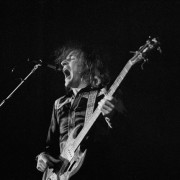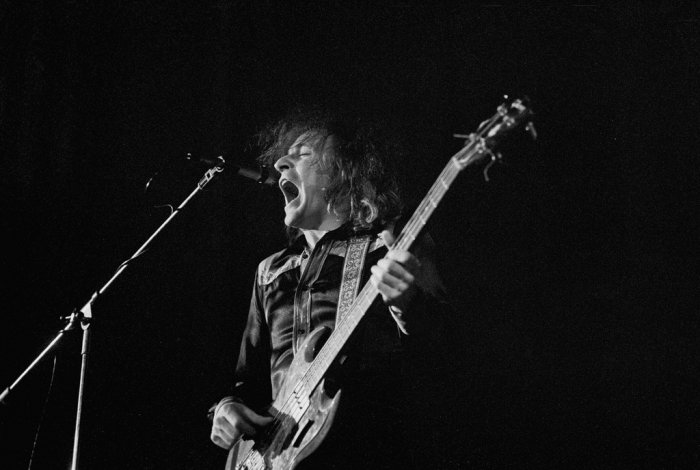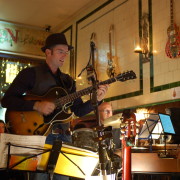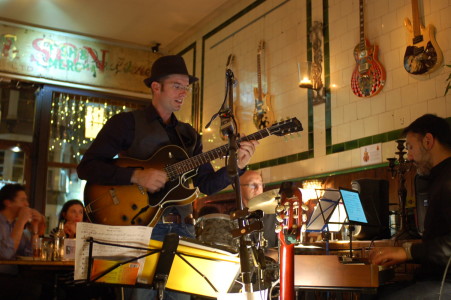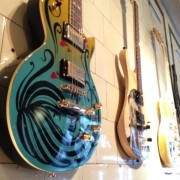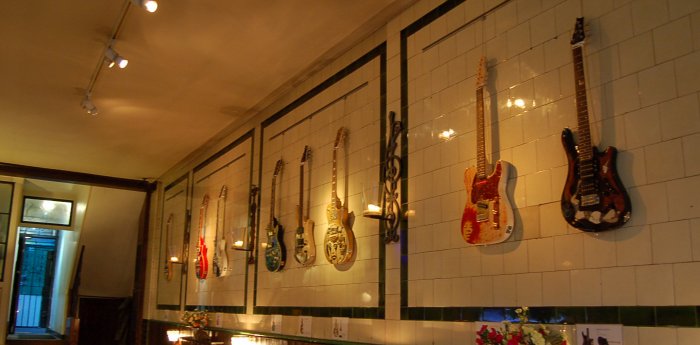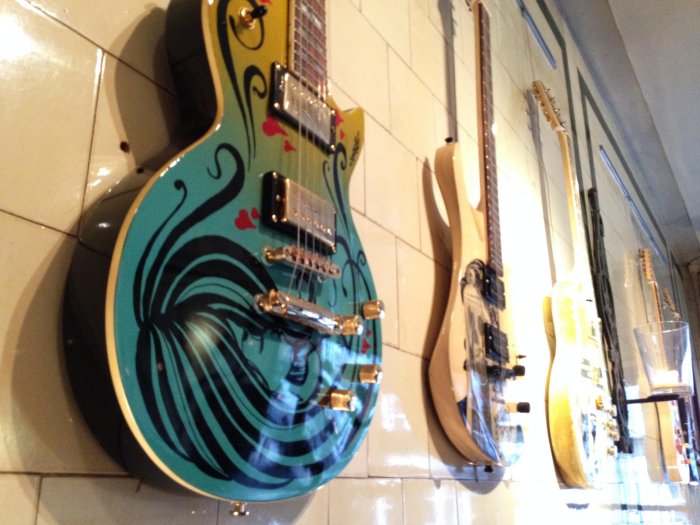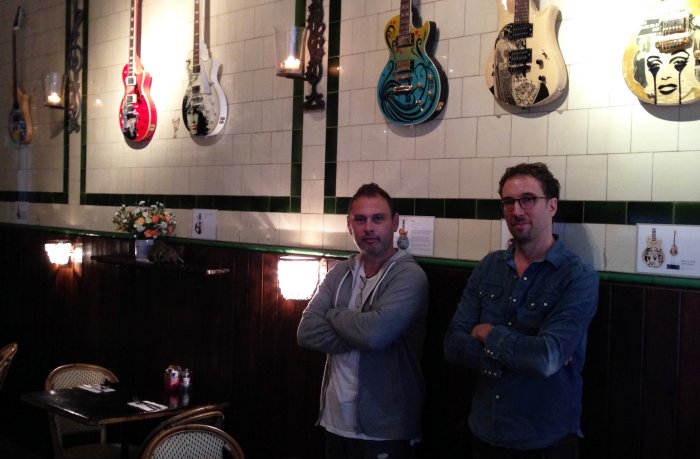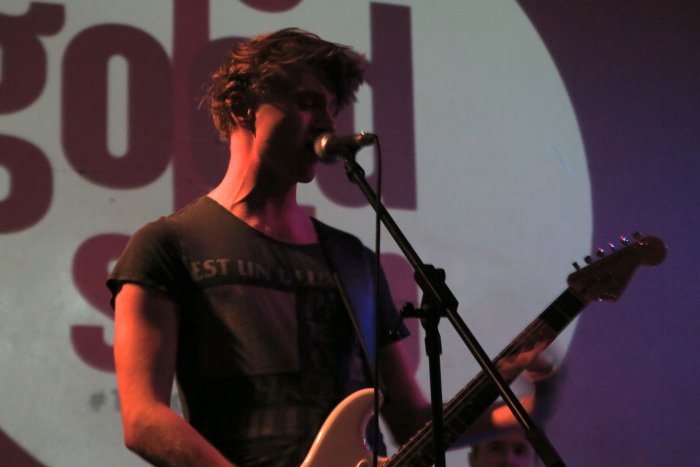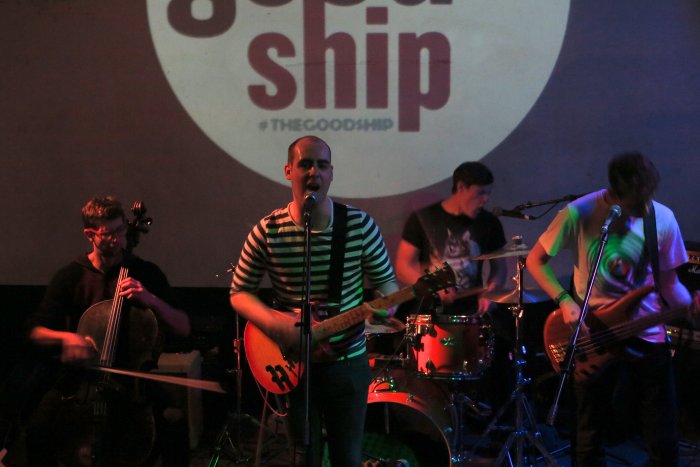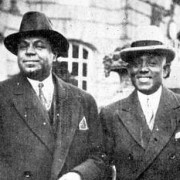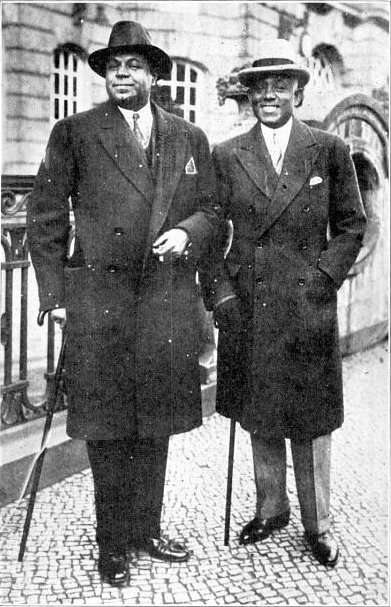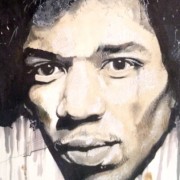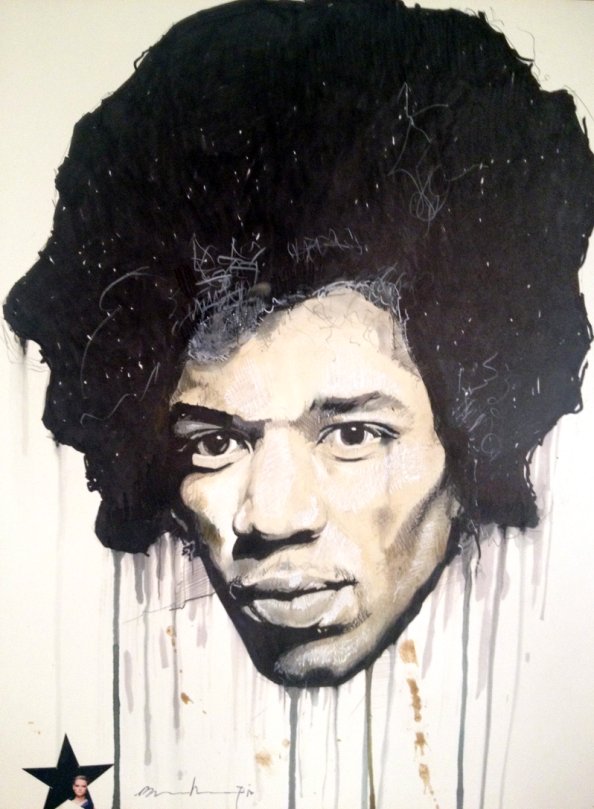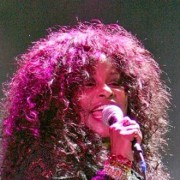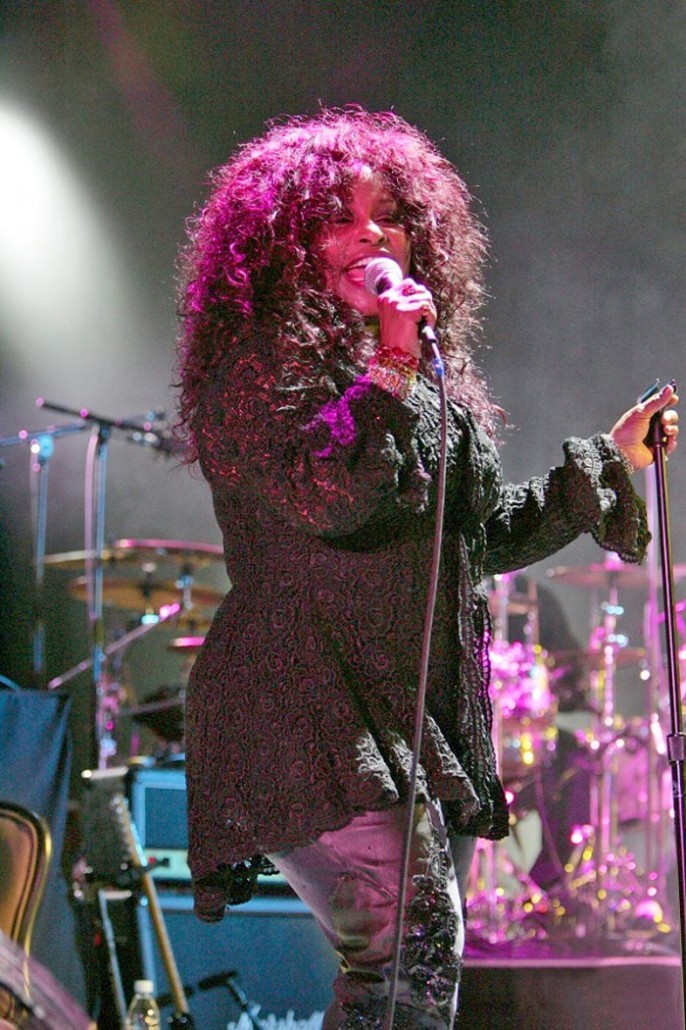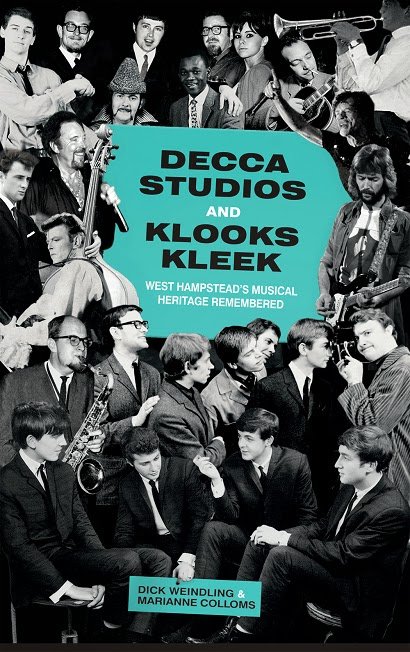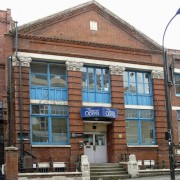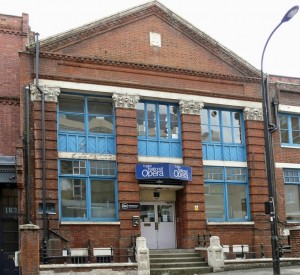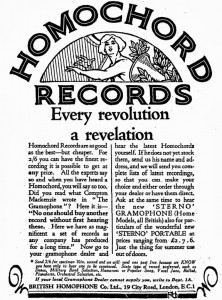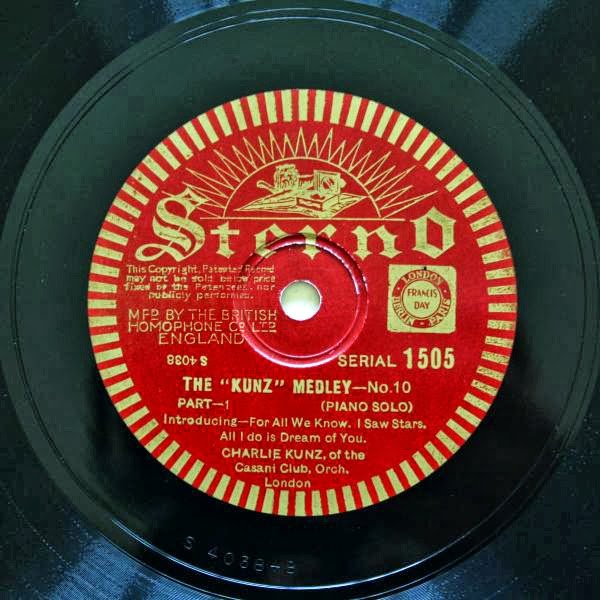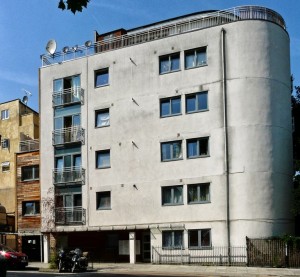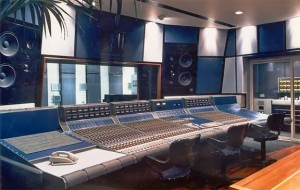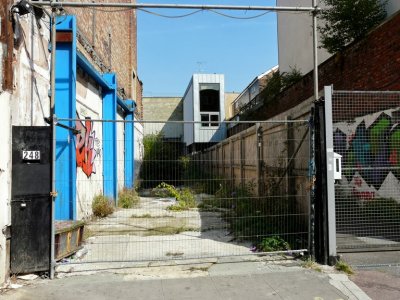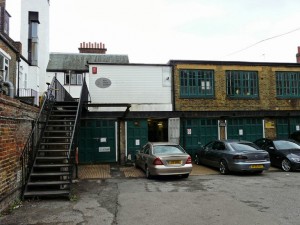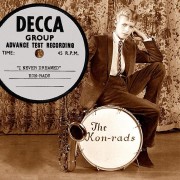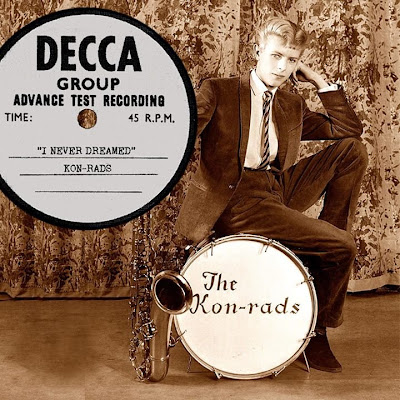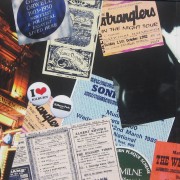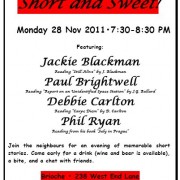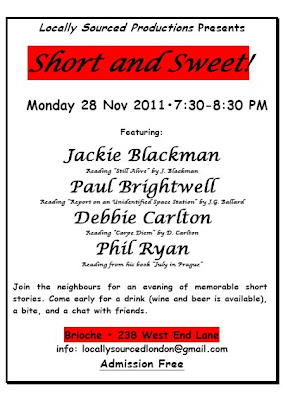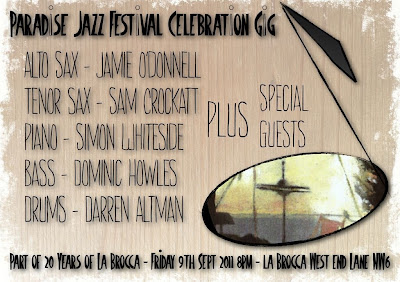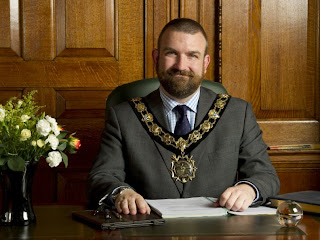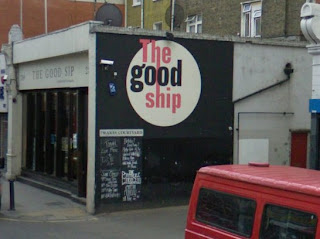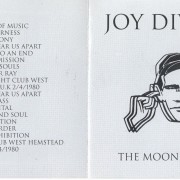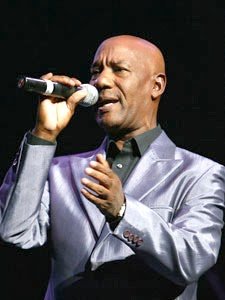
Errol Brown
This is the second part of our trilogy. Here’s the link to part one.
Thanks are due to Ade Wyatt, Simon Inglis, Dean Austin, Wally Smith, Pat Wilkinson, Adam Sieff, Phil Shaw, Steve York, Val Simmonds, Brian Wilcock, James Moyes, Dave Kemp and Peter Murray for their help in identifying some of the musicians.
Cleo Laine, Johnny Dankworth, Stan Tracy, and Dudley Moore –80 Kilburn High Road
This building, next to Sainsbury’s in Kilburn High Road, was full of jazz musicians. Singer Cleo Laine lived upstairs with bandleader and composer Johnny Dankworth. One of the early British jazz musicians, Dankworth composed music for many 60s films and he and Cleo often appeared on TV. After a long and successful career he died in February 2010 just as Cleo had organised a concert for him. She decided it would go ahead and the audience were shocked to hear about Johnny’s death.
Stan Tracy lived on the middle floor of the Kilburn High Road building. For many years he was the house pianist at Ronnie Scott’s club. His 1966 album called ‘Under Milk Wood’, a jazz suite inspired by the Dylan Thomas play, is one of the most celebrated jazz recordings. Already awarded an OBE, Stan was given a CBE in the 2008 New Year Honours list.
Out of work, Dudley Moore had returned from New York and Dankworth gave him a job as pianist in his band. Dudley slept on a sofa in Cleo and John’s Kilburn High Road flat. In 1960 Dud joined Peter Cook, Jonathan Miller and Alan Bennett in ‘Beyond The Fringe’ which became a huge success. For more than ten years Pete and Dud had a very successful double act on TV and then Dudley went to Hollywood and stardom with the 1979 film ‘10’. Dudley was a highly talented jazz pianist influenced by Oscar Peterson and Errol Garner, who regularly performed with his trio.
Maurice McElroy and Wes McGhee – West Hampstead
Maurice was born in Belfast and started to play the drums when he was thirteen. He was in local bands before he came to London at the end of the 60s. Maurice played drums in soul bands in US bases in Germany and then met singer-songwriter Wes McGhee. They have worked together since 1970 and both lived in West Hampstead. Since 2000 Maurice has played with guitarist Ben Tyzach and bass player Constance Redgrave in the band Spikedrivers.
Wes McGhee was from Leicestershire and played guitar in a local band when he was thirteen. After time playing in German rock clubs, Wes got a record deal with a division of Pye Records. This was not a good experience and Wes formed his own Terrapin Records label. After receiving positive US reviews, Wes went to Texas where he played with many of the leading local musicians. He has written music for theatre and TV.
Mike Hall – 30c Priory Terrace, 63 GondarGardens, and 21 Iverson Road
Keyboards player, Mike Hall was brought up in North Wales where he played in local bands and Lemmy, later of Motorhead, was a roadie. Mike came to London in the 1960s. He said:
In 1969 Christine Perfect offered me the job of keyboard player with her band when she left Chicken Shack and went solo. She then changed her mind and did the keyboard work herself, but only did one tour before marrying John McVie and joining Fleetwood Mac. Then I played with a band called Canterbury Glass. We made an album at Olympic studios, and had the pleasure of hearing the Stones and Humble Pie recording at the same time. I was also doing work with blues singer/harp player Duffy Power during this time; gigs including Les Cousins, and the Marquee, and we recorded a session at the Maida Vale studios for Mike Raven’s show for BBC radio.
He remembers the night in October 1967 at Klooks Kleek in West Hampstead, when he heard Jimi Hendrix sitting in with John Mayall’s band. In 1972 Mike moved to GondarGardens and played regularly with the Lee Lynch Sound. Lee was an ex-Irish showband singer, whose show included everything from Country music to Presley covers. Then Mike joined Union Express with tours in Englandand Europe, and recording sessions for a single in Decca Studios. In 1975 he began a three year course at Leeds College of Music, followed by night club, big band, cabaret and cruise ship work in many parts of the world. During his time on the QE2 Mike played for The Queen, Princess Diana, Lana Turner, Stewart Grainger, and many other movie stars. Today Mike has returned to North Wales where he still plays and teaches.
Joe Palmer – 250 West End Lane.
In the 1970s, Joe Palmer was one of the founders of the successful ‘Peelers’ folk club in 1968, and from that grew ‘Peelers,’ a popular folk group led by Joe, with Tom Madden, and Jim Younger. Their 1972 album Banish Misfortune used old acoustic instruments such as the dulcimer, banjo, tin whistle, guitar and concertina.
Joe ran a record shop at 250 West End Lane. Marianne remembers the shop – which later became a video rental store still run by Joe – as very dark, with painted walls. Today Joe Palmer lives in Spain and runs Sunshine FM on the Costa Blanca.
Brian Eno, Gavin Bryars, Evan Parker, Howell Thomas and Graham Simpson –28 Brondesbury Villas
In 1971 Brian Eno moved into a room in 28 Brondesbury Villas which had lately been vacated by Gavin Bryars, the composer and bassist. This was another house full of musicians. At the front was Evan Parker (sax); the pianist Howell Thomas lived below Eno and the late Graham Simpson, bass and co-founder of Roxy Music, had the ground floor. After this Eno moved to LeithMansions, Grantully Road, Maida Vale. But in 1994 he was back in a flat at 28 Brondesbury Villas. Eno was a member of Roxy Music from 1971 to 1973. He has worked as a producer with David Bowie, Coldplay, Talking Heads, Depeche Mode, Paul Simon, Grace Jones, and U2 among many others.
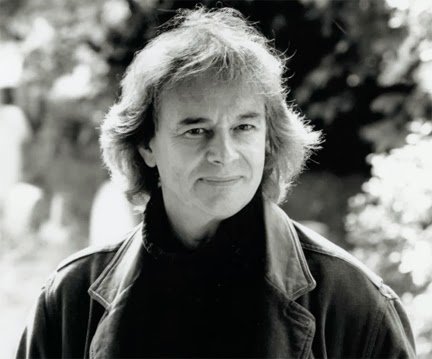
Colin Bluntstone
Colin Blunstone – Inglewood House, West End Lane
Colin was the lead singer with a very distinctive voice in The Zombies. The band was formed in 1962 in St Albans by school friends, Colin, Rod Argent (keys), Paul Atkinson (guitar), Chris White (bass) and Hugh Grundy (drums). They signed to Decca and in 1964 released ‘She’s Not There’ which became their biggest hit. The breathy vocals of Colin and the jazz-tinged keyboards of Rod Argent was a noticeable feature of the Zombies and the song reached number 2 in the US. Their other well known song was ‘Time of the Season’ (1968). When the band broke up Colin began a solo career and he had some success in 1972 with ‘Say You Don’t Mind’ which reached number 15 in the UK. He released several albums on Elton John’s record label and was the vocalist with the Alan Parsons Project. Colin was living in Inglewood House, on the corner of Inglewood Road and West End Lane, in 1972 and 1973.
Alan Lee Shaw – West Hampstead
Alan moved to the area in 1975 after art school in Cambridge. When the punk explosion began he formed a band called The Rings. He worked as a singer and guitarist with several other bands including, The Maniacs (1977), and The Physicals (1977 to 1980). Alan was with guitarist Brian James in other bands and then in the reformed The Damned from 1993 to 1995.
Phil Lynott – WelbeckMansions, Inglewood Road, and Embassy Court, West End Lane.
Philip Parris Lynott, singer and bass player, was born in West Bromwich but when he was four he went to live with his grandmother in Dublin. He formed the band Thin Lizzy in 1969 and they recorded their first album at the Decca Studios in 1971. They had big hits with ‘Whiskey in the Jar’ (1973) and ‘The Boys are Back in Town’ (1976). In 1973 he was in Welbeck Mansions with his girl friend Gale Barber. By 1976 Phil was living at Embassy House. His heroin addiction led to his collapse on Christmas Day 1985 at his home in Kew and he died on 4 January 1986.
Candy McKenzie – Kilburn
Candy worked as backing vocalist for many bands including Bob Marley, Aswad, Gary Moore, Go West and Leonard Cohen. Candy was living in Kilburn in 1977 when she went to Jamaicato record with Lee ‘Scratch’ Perry at his Black Ark studios. The album has been released as Lee Scratch Perry Presents Candy McKenzie. She married and in 2003 she was living in Willesden.
Annie Ross – 12a Douglas Court West End Lane, and Ellerton Mill Lane
Jazz singer Annie Ross was born as Annabelle Allan Short in Mitcham, the daughter of Scottish vaudeville performers. Her brother was the entertainer Jimmy Logan. When she was four the family went to America and she got work as a child singer and performer. As Annie Ross she began recording as a jazz singer in 1952. In 1958 she recorded an album with Gerry Mulligan, baritone sax, and Chet Baker on trumpet. She is probably best know for her work with Dave Lambert and Jon Hendricks as the trio, Lambert Hendricks and Ross, who recorded seven best selling albums between 1957 and 1962. She left the group and came to London where she opened her own nightclub, Annie’s Room, in 1964. In addition to solo recordings and theatre work, she appeared in a number of films including, Superman III, Throw Momma from the Train, and Short Cuts.
Annie had a relationship with jazz drummer Kenny ‘Klook’ Clarke and the comedian Lenny Bruce. In 1963 she married the actor Sean Lynch, but they were divorced in 1975 and he died soon afterwards in a car crash. She had drug and finance problems and became bankrupt in 1978. Annie lived at 12a Douglas Court (numbered so as to avoid the superstitious number 13), from at least 1978 to 1983 and then moved to Ellerton the block of flats in Mill Lane.
Adam Ant – Sherriff Road
Adam’s real name is Stuart Leslie Goddard and he grew up in St John’s Wood. Before he achieved success, Adam squatted in Sherriff Road. After working in several bands, Adam formed The Ants who played several times at the Moonlight Club in the Railway Hotel in 1978. Adam and the Ants had ten top ten hits from 1980 to 1982, including ‘Stand and Deliver’ and ‘Prince Charming’. He then had a solo hit with ‘Goody Two Shoes’.
Clive Sarstedt – Kilburn and West Hampstead
Clive and his brothers Richard and Peter Sarstedt were born in India and the family returned to Englandin 1954. The three brothers all became musicians. Richard became Eden Kane who had a number one hit with ‘Well I Ask You’ in 1961. Clive Robin became Wes Sands and had a hit in 1976 with ‘My Resistance is Low’. Peter kept his name and had a huge hit single with ‘Where Do You Go To My Lovely’ which reached number one in 1969. Only Clive lived locally: he was in Kilburn in 1981 and West Hampstead in 1985. Clive, as Wes Sands, recorded his debut single ‘Three Cups’ in 1963 with the legendary producer Joe Meek, who was also his manager.
Hazel O’Connor – Hemstal Road
Singer, songwriter and actress, Hazel was born in Coventry. In 1980 she played punk rocker Kate in the film ‘Breaking Glass’. This won her a Best Actress award in Britain, and the soundtrack reached number 5 in the UKcharts. She has made more than twenty albums and appeared in numerous theatre, film and TV parts. During the 1980s Hazel lived in a flat on the fourth floor of Beacon House in Hemstal Road. One of the residents remembers the fans waiting outside and that Hazel used to walk her Alsatian dog on the roof. She now lives in Ireland.
Dave Dee – Wavel Mews
A neighbour says that David John Harman of the band, Dave Dee, Dozy, Beaky, Mick and Tich, lived in Wavel Mews. The five friends from Wiltshire originally formed a band in 1961 called Dave Dee and The Bostons. In 1964 the name was changed to the more memorable Dave Dee, Dozy, Beaky, Mick and Tich, which were their nicknames. They had several hits between 1965 and 1969 and two of their singles, ‘The Legend of Xanadu’ and ‘Bend It’, sold over a million records each. David died in January 2009.
David Van Day – Wavel Mews
David Van Day and Thereza Bazar formed Dollar in 1978 and their first single ‘Shooting Star’ reached number 14. Later singles, ‘Love’s Gotta Hold on Me’, ‘Mirror Mirror’ and ‘Give Me Back My Heart’ each reached number 4. In 1981 David was living in Wavel Mews.
Lynsey De Paul – FairfaxGardens
She was born as Lyndsey Monckton Rubin in 1948. Her parents Herbert and Mena lived at 98 Shootup Hill. Herbert was a property developer. After leaving the HornseyArtSchool, Lynsey designed album covers and then began writing songs. In 1972 she performed her own song ‘Sugar Me’ which reached the UK top 10 and was covered in the US by Nancy Sinatra. She has had written many other successful songs and appeared on TV.
Jimmy Nail – 50 Maygrove Road
Actor and singer, Jimmy Nail was one of the stars of the TV series Auf Wiedersehen Pet. When filming finished in 1983 he had what he called his first proper London home at 50 Maygrove Road. When the show was first shown Jimmy said:
I walked along to the end of the street and on to the Kilburn High Road to get a newspaper and read a review of the show, if there was one. All of a sudden all these car horns were honking. I wondered what all the fuss was about, until I saw people hanging out of their cars pointing, waving and shouting — at me. People in the street were coming my way, lots of them. I ran home with a mob on my tail, got in and locked the door. People were climbing up the railings and peering through the windows. I hid behind the settee and wondered what had happened. Fame had happened, and I was woefully ill-prepared for it. I didn’t know what to do. Everywhere I went there was madness. It was more than fame, it was hysteria. People believed Oz was me and I was him. I tried to explain he wasn’t real, but they didn’t want to know.
From Jimmy Nail’s autobiography, ‘A Northern Soul’, 2004
Jackie McAuley – Kilburn
Born in Northern Ireland, singer and guitarist Jackie McAuley was a member of Them with Van Morrison. After the breakup of the band, Jackie kept the name as Them Belfast Gypsies. He latter teamed up with Fairport Convention singer Judy Dyble and recorded as Trader Horne. In the 70s and 80s Jackie was a session player on records by Jim Capaldi and Rick Wakeman. He also worked with Lonnie Donegan’s band and set up a Celtic rock band called Poor Mouth.
Barry Mason – 22 Priory Terrace
(John) Barry Mason is an important songwriter who has written hundred of songs including ‘Delilah’, Tom Jones’ big hit. Elvis recorded Mason’s ‘Girl of Mine’ and Rod Stewart did ‘That Day Will Come’.
Craig Collinge – Woodchurch Road
Craig was born in Sydney and started playing drums at a young age with local bands. He came to London in 1969 and joined Manfred Mann Chapter Three. He also played with Third World War, Shoot and the Frankie Reid Band. Craig also toured with Alan Price. In 1973 the manager of Fleetwood Mac put together a band, without any of the original members, to complete their remaining engagements. Craig joined the band after answered an advert in the Melody Maker, and toured with them until the manager was sued. He returned to Australia about 1976.
Chrissie Hynde – Canfield Gardens
American born Chrissie moved to London in 1973 and formed The Pretenders in 1978. Their first album was released in December 1979 and they have made eight albums. Two of the original members, James Honeyman-Scott and Peter Farndon both died of drugs.
Stewart Copeland and Sonja Kristina – Hillfield Road
Stewart was born in Virginia, the youngest son of Miles Copeland, a CIA officer. He came to Englandin 1975 and was a roadie for Wishbone Ash and Renaissance and the tour manager for Curved Air and Joan Armatrading. Stuart formed The Police in 1977. In 1978 he had a flat in Hillfield Road, West Hampstead which he shared with Sonja Kristina, the lead singer of Curved Air. In September 1978 Stewart and Sonjamoved to 21 LenaGardens, Shepherd’s Bush. They were married in 1982 and had three children. They split up after sixteen years when Stuart moved to Los Angeles.
Edwyn Collins – West Heath Studios, Mill Lane, and Kilburn
Singer-songwriter Edwyn formed the band Orange Juice in 1979 and their single ‘Rip It Up’ went to number 8 in the charts. His big solo hit was ‘A Girl Like You’ in 1994. This was recently used in a 2012 TV advert. In 2005 he suffered a serious brain haemorrhage but has now recovered and is performing again. He has recorded and produced records at his West Heath Studio in Mill Lane. He lives in Kilburn with his wife Grace.
Paul Cook – Kilburn
Paul Cook the drummer with the Sex Pistols, grew up in Hammersmith. About 1972, Paul and school friends Steve Jones and Wally Nightingale formed a band called The Stand. By 1975 they became the Sex Pistols and achieved success with their manager Malcolm McLaren. After a final Pistols concert in San Francisco in January 1978, Paul and Steve Jones continued working together with a new band called The Professionals. In the early 80s they discovered Bananarama and Paul Cook produced their first album Deep Sea Diving. Cook joined a re-formed Sex Pistols and they were a headline act at the 2008 Isle of Wight Festival. He has played with several bands, including that of Edwyn Collins. He lived in Kilburn about 1977/78.
Annabella Lwin – near Sumatra Road
In 1980, fourteen years old Annabella had a Saturday job in a Kilburn dry cleaners when she was discovered by a colleague of Malcolm McLaren. She auditioned and McLaren made her lead singer with Bow Wow Wow, which was made up of several members of Adam Ant band. Their first top ten hit was ‘Go Wild in the Country’ (1982).
Steve Severin and Spizz – Priory Road
Steve (Stephen John Bailey) was the bassist and co-founder of Siouxsie and the Banshees in 1976. Around 1980 he had a flat in Priory Road which he shared with Spizz 77 (Kenneth Spiers), the singer with a punk band who changed their name often.
James Honeyman-Scott – Westside, 55 Priory Road
In 1981 Jimmy, the guitarist with The Pretenders, was living in Priory Road. He died from heart failure associated with cocaine in July 1982, aged just 25.
Jeremy Healy, Kate Garner and Paul Caplin (Haysi Fantayzee) – Sandwell Mansions, West End Lane
Formed in 1981, the members of Haysi Fantayzee were living in a West Hampstead flat owned by Paul Caplin. One night Jeremy wrote the lyrics to oddly titled, ‘John Wayne is Big Leggy’. He woke everyone up and announced that he had written their first hit. In 1982 this reached number 11. Kate Garner went on to become a successful photographer.
Don Powell – 37 Platts Laneand 23 Cavendish Mansions, Mill Lane
Don was the drummer with Slade, a Wolverhampton band. In 1973 he had a serious car crash and his girlfriend was killed. He bought a flat in Platt’s Lane in 1976 and lived there until about 1980 when he moved to Cavendish Mansions. He was in Cavendish Mansions until 1985. Slade were formed in 1969 and became very popular, making over 30 albums. The original band broke up in 1992. Don Powell now lives in Denmark.
Barrie Masters – Cavendish Mansions, Mill Lane
Singer Barrie was an original member of the band, Eddie and the Hotrods formed in CanveyIsland in 1975. He lived in Cavendish Mansions in the early 1980s. After gained a reputation as a live act they had a residency at The Marquee in 1976. The opening act was The Sex Pistols playing their first London gig. The Hotrods most successful record was ‘Do Anything You Wanna To Do’ which reached number 9 in 1977. That year they toured the US with The Ramones and Talking Heads. There were various personnel changes: one of the first to leave was Eddie, who was a tailor’s dummy. The band disbanded in 1981 and Masters joined The Inmates, other members joined The Damned. Later Barrie rejoined the band and The Hotrods have made over a dozen studio and live albums. They are still touring and in 2012 they supported Status Quo.
Tony Bagget – Kilburn
Tony is a bass player who still lives in Kilburn. He was in the punk band Cuddly Toys which formed in 1979 from a previous group. Their first release was ‘Madman’ a song written by David Bowie and Marc Bolan shortly before his death. It reached number 3 in the UK Indie Chart.
Seal – Brondesbury Villas
Seal Henry Olusegun Olumide Adeola Samuel, to give him his full name, was born in Paddington in February 1963. His mother was Nigerian and his father was Brazilian. He spent his infant years with a guardian away from his family. After four years he was reunited with his family and grew up with his older sister and four younger siblings in Kilburn. His best known hit was ‘Kiss From A Rose’ which won a Grammy Award in 1996. He married the model Hedi Klum in 2005 and they divorced in 2012.
Paul Jones – 182 Willesden Lane, and Garlinge Road
Paul is the singer and harmonica player with The Blues Band. He was born as Paul Pond in Portsmouth in 1942, the son of a Royal Navy Captain. He sang with Manfred Mann’s band from 1962 to 1966 and they had hits with ‘5-4-3-2-1’ and ‘Do Wah Diddy’. The Blues Band was formed in 1979 by Paul and guitarist Dave Kelly. Today Paul hosts a regular rhythm and blues show on BBC Radio 2.
Ronnie Scott – Messina Avenue
Jazz club owner and tenor saxophonist, Ronnie Scott was living in Messina Avenue in 1981 when he was awarded the OBE in the New Year Honours. He helped Dick Jordan and Geoff Williams who ran Klooks Kleek at the Railway Hotel, by allowing famous American jazz players to perform there before they played at his Frith Street club. Ronnie also played several times at Klooks on jazz nights.
Errol Brown – 84 Hillfield Road. Tony Wilson – 64 Hillfield Road
The founders of Hot Chocolate both lived in Hillfield Road. Born as Lester Errol Brown in 1948 in KingstonJamaica, at the age of 11 Errol and his mother came to England. He said: ‘To begin with we lived in a room of a cousin’s big house in Gipsy Hill, South London.’ When he was 14 they moved to 84 Hillfield Road, West Hampstead and he went to Warwick House, a small private school at 30 Lymington Road. Errol continued:
In 1968, through mutual friends, I met Tony Wilson whose flat was almost opposite mine. Tony and I formed Hot Chocolate, and I sat down and wrote new words to John Lennon’s “Give Peace a Chance”. We demoed the song but being so new we had no idea you needed permission. The guy that paid for the recording sent it to the Apple label for John’s approval. We all laughed but four days later he called and said: “John Lennon loves it and wants to put it out straight away!
In 1970 the debut single of Hot Chocolate, ‘Love is Life’, reaches number 6 in the UKcharts. A string of hits followed including, ‘It Started with a Kiss’ and ‘Everyone’s a Winner’. In 1981 the band performed at Prince Charles and Princess Diana’s wedding reception. In 1997 their previous 1975 hit, ‘You Sexy Thing’, was revived in the film ‘The Full Monty’. It’s believed that Errol may have later lived near Sherriff Road.
Michael Jeans – West Hampstead
A classically trained oboe player, Michael performed with John Williams on the soundtrack of Star Wars in 1980. He has been in the band Talk Talk since 1988, with the violinist Nigel Kennedy. Michael has made two solo albums, Eagle on the Wind (2002) and Leather and feathers (2005).
Sheena Easton – Mill Lane
In 1981 Sheena moved from a shared flat in south London to her own flat in Mill Lane. She was born in Scotland as Sheena Shirley Orr in 1959. The 1979 BBC TV documentary, Big Time, which followed her progress in the music business, propelled her to success. Her theme song for the 1981 James Bond film, For Your Eyes Only, was a top ten hit in the UK and US. Sheena has had a very successful career winning two Grammy Awards, achieving seven Gold albums and one Platinum and has sold over 20 million records worldwide.
Geno Washington – 212 West End Lane
In 1983 Geno co-owned a basement restaurant at 212 West End Lane, but he probably did not live there. About 10.30 he would sing blues songs such as ‘Little Red Rooster’ and ‘Got My Mojo Working’ to the diners. Born in Indiana, Geno was stationed in Englandwith the US Air Force in the 1960s. In 1965 he was asked by guitarist Pete Gage to front his band which became Geno Washington and the Ram Jam Band. They played in all the London Blues clubs including West Hampstead’s Klooks Kleek, and had two best selling live albums in 1965 and 1966. In 1971 Gage formed Vinegar Joe with ElkieBrooks and Robert Palmer in the early 1970s. Kevin Rowland’s big 1980 hit ‘Geno’ was based on hearing Washington at gigs where the fans shouted ‘Geno! Geno! Geno!’ Washington is still performing today.
Jimmy Somerville – 12a Inglewood Rd
In 1983 Jimmy Sommerville co-foundered Bronski Beat with the other members of the band. They had a hit with their first record, ‘Smalltown Boy’. In 1985 Jimmy and Richard Coles formed The Communards. Their record ‘Don’t Leave Me This Way’ stayed at number 1 for four weeks in 1986. After two years he went on to a successful solo career.
Loudon Wainwright III – Inglewood Road
Singer-songwriter Loudon Wainwright was born in North Carolina in 1946. His father who was an editor for Life magazine, played piano and the records of Tom Lehrer and Stan Freberg to his children and these had an influence on young Loudon. He started playing guitar in the late 1960s and while living in Rhode Island he wrote about 20 songs in a year. He was discovered when he was playing in New York folk clubs and released his first album on Atlantic Records in 1970. He is perhaps best known for his 1972 novelty song ‘Dead Skunk (in the middle of the road)’. In 1974-75 he played the part of Captain Spalding, the ‘singing surgeon’ in several episodes of the hit TV series of M*A*S*H. He has also appeared in several films, such as The Aviator and Big Fish. He was the regular singer on Jasper Carrott’s TV show in the late 1980s. Wainwright has recorded over 20 albums, several of which were nominated for Grammy Awards and in 2010 won a Grammy for High Wide and Handsome. In 1986 he lived in a top floor flat in Inglewood Road.
Herbie Flowers – West Hampstead Mews
In the late 1980s renowned bass player, Herbie Flowers had a recording studio in his house in West Hampstead Mews. He was a member of Blue Mink, T. Rex and Sky. Herbie was a session player on hundreds of records, including those by Elton John and David Bowie. He is best known for the bass introduction on Lou Reed’s 1972 ‘Walk on the Wild Side’.
Kevin Rowland – West Hampstead, Marlow Court Willesden Lane
Kevin achieved success with Dexy’s Midnight Runners which was formed in Birmingham in 1978. Their record ‘Geno’ about Geno Washington was a number 1 hit in 1980. ‘Come On Eileen’ was another number 1 in 1983. They disbanded in 1987. In an interview for The Guardian he said that in 1987, with the music business closing its doors and his self-esteem at an all-time low, he sought out cocaine. At his worst, he was spending £360 a night. Friends and family were frozen out. ‘Drug dealers were my gods.’ The following year he went bankrupt with debts of over £180,000. Evicted from his flat in West Hampstead, Kevin got a place in Willesden, stopped paying the rent and squatted. In 2012 now known as just Dexy’s they released a fourth studio album after 27 years.
Nick Beggs – Priory Terrace
In 1979 bass player Nick Beggs formed the band Art Nouveau, with Steve Askew, Stuart Croxford Neale and Jez Strode. Chris Hamill (who used the name Limahl), joined the band in 1981 and it was renamed Kajagoogoo. In 1983 their first single, ‘Too Shy’ reached number 1in the UK Singles Chart. After Limahl and Strode left, the three remaining band members worked as Kaja. A reformed Kajagoogoo with Beggs, Askew and Neale toured in 2004. Since then Limahl and Strode have both rejoined and the band has toured extensively over Europe in 2008 and 2009. Nick Beggs has worked with a large number of other musicians including, Howard Jones, ABC, Cliff Richard, Tina Turner, D:Ream, Gary Numan, and Kim Wilde.
Bros – Exeter Road
Twins Matt and Luke Goss, together with Craig Logan formed Bros in 1986. They had eleven top 40 singles and three Top 20 albums, making them one of the biggest acts between 1988 and 1991. They reached number one when ‘I Owe You Nothing’ was reissued in 1988. They continued having hits throughout the late 1980s, including ‘Cat Among the Pigeons’ and ‘Too Much’, both which made number 2 during 1988 and 1989. About 1988 and 1989 they are believed to have lived in Exeter Road, near Kilburn Station.
Boz Boorer and Alain Whyte – West Hampstead
Boz Boorer and Alain Whyte are guitarists, song writers and record producers who live in West Hampstead. In 1977 Boz formed a band called Cult Heroes which became The Polecats and they released a single, ‘Rockabilly Guy’ in 1979. The following year they made their most successful album, Polecats Are Go! They had success in the UK and US charts.
Since 1991, Boorer and Alain Whyte have worked closely with Morrissey. The distinctive sound which Boorer and Whyte produced has been credited with revitalizing Morrissey’s career. Boorer has made solo albums and worked with other artists including Adam Ant, Joan Armatrading, Kirsty MacColl, Jools Holland and Edwyn Collins. Alain Whyte is best known for being Morrissey’s song writing partner, but he has also written material for Madonna, Rihanna, Chris Brown and The Black Eyed Peas. In 2005 he was with a band called Red Lightning.
Bernard Butler– Fawley Road
In the early 1990s Bernard lived in Fawley Road in West Hampstead. He was the guitarist with Suede who were formed in 1989. The original band consisted of Brett Anderson, vocals, Bernard Butler, guitar, Matt Osman, bass, and Simon Gilbert on drums. Their best selling debut album, Suede was released in 1993 and it won the Mercury Music Prize. Their second album Dog Man Star was recorded in 1994 at Master Rock Studios in Kilburn. In 1994 Bernard formed the duo McAlmont and Butler with singer David McAlmont who lived in Belsize Road. In 2004 Butler and Brett Anderson reunited with the band The Tears.
Bernard has worked as a producer on a number of records at Edwyn Collins’s West Heath Studios in Mill Lane. He has worked with Duffy on the five million selling album Rockferry. He has produced records for the Black Kids, Cajun Dance Party, the 1990s and many other groups. In 2008 and 2009 Butler won several best record producer awards.
Natalie Imbruglia – Goldhurst Terrace
Australian born singer, actress and model, Natalie, lived in the area since 1998. After appearing in the TV soap Neighbours from 1992 to 1994, she began a singing career and her debut album, Left of the Middle (1997), has sold over 6 million copies. Her best selling single, ‘Shiver’ reached number 1 in 2005. In 2010 Natalie was a judge on The X Factor and she has continued her singing and acting careers.
Alexander O’Neal – West Hampstead
R&B singer Alexander O’Neal was born in Natchez, Mississippi. He has lived in London since about 1999. He said in an interview, ‘I spent nine months of every year travelling between the States and England.’ He released his first album in 1985, and the 1987 single ‘Fake’ was number one in the American R&B chart. Other successful records were, ‘If You Were Here Tonight’ which reached number 13 in the UK, and ‘Criticize’ which was number 4 in the UK in 1987.
Lord Eric Carboo – Kingsgate Road
Still living in Kilburn, Lord Eric is the leader and percussionist with Sugumugu, an African drumming and dance group. He has worked for many years performing and promoting The Master Drummers of Africa.
Sophie Ellis-Bextor – West Hampstead
In 2002 singer and model Sophie Ellis-Bextor lived in a West Hampstead flat with her manager Andy Bond. In 1997 she came to prominence as the lead singer with indie band Theaudience. After two years the band split up and she went solo. In 2000 she added vocals to Italian DJ Spiller’s instrumental ‘Groovejet (If This Ain’t Love)’ which went to number 1, and the record won several awards. Her single ‘Murder on the Dancefloor’ became Europe’s most played record in 2002. Sophie has now made five albums and she is a contestant in this year’s Strictly Come Dancing. She is married to bass player Richard Jones and they have three children.
Rachel Stevens – West Hampstead
Rachel lived in a Hampstead flat for three years before buying a mews house near Fortune Green Road in 2004. She was a member of the pop group S Club 7 who had a TV series in 1999. During the five years they were together the group had four UK number 1 singles and a number 1 album. They sold 14 million albums worldwide. After they disbanded in 2003 Rachel began a solo career. She has appeared in several films and the 2008 series of Strictly Come Dancing.
Elliott Randall – Kilburn
It is not known how long American guitarist Elliott Randall has lived in the Kilburn area. Elliott is a session guitarist who has played on hundreds of well known records. He grew up in New York where he was a friend of Donald Fagan and Walter Becker. They moved to LA and became Steeley Dan, releasing their first album Can’t Buy a Thrill in 1972. They asked Elliott to record guitar solos and he best known for his work on ‘Reelin in the Years’. Reportedly, Jimmy Page said this is his favourite guitar solo. Elliott also played on Steely Dan’s later albums Katy Lied (1975) and The Royal Scam (1976). As a session player he has worked with John Lennon, The Doobie Brothers, Carly Simon, ElkieBrooks, and Peter Frampton. Elliott gives workshops and plays with bands here and in the US. There is a great duet with Mick Abrahams on YouTube: http://www.youtube.com/watch?v=oYGbnDs8DMI&list=RD02N9-ZlCpL17E
Adam Sieff – Kilburn
After living in Willesden, Adam has lived in Kilburn for the last three years. Adam is a guitarist and record producer and is currently executive producer at Gearbox Records. He has worked as a session player on records and for many TV shows including, Spitting Image, Who Dares Wins, Ben Elton and Fry and Laurie. Adam was the jazz manager at Tower Records for three years, Head of Sony Jazz for ten years and an original member of SellaBand, the first music crowdsourcing website. He has worked with artists such as Herbie Hancock, The Bad Plus, Martin Taylor, Clare Teal, Wasted Youth, Alex Korner, Wynton Marsalis, KebMo and Jazz Jamaica.
Stephen Lipson – West Hampstead
Currently living in West Hampstead, Stephen is a guitarist, record engineer and producer who has worked with many major musicians including; Frankie Goes to Hollywood, Pet Shop Boys, Grace Jones, Cher, Annie Lennox, Paul McCartney and Jeff Beck. In 2006 with Trevor Horn who ran ZTT Records, Lol Crème, and Ash Soan, they formed a band called Producers to allow the friends to play as a break from producing records. They played gigs in CamdenTown and in 2012 they released an album, Made in Basing Street, named after the address of Sarm Studios.
Andrew McCulloch – Fordwych Road
Andy is a drummer who has worked with Manfred Mann, Greenslade, The Crazy World of Arthur Brown, and is best known for his work with King Crimson who he joined in 1970. He gave up drumming to peruse his love of boats, and now charters his own yachts and teaches sailing.
Sean Taylor – Kilburn
Singer-songwriter Sean Taylor was born and still lives in Kilburn. He has played at the Glastonbury Festival four times. Sean released six albums between 2006 and 2013. One of the tracks on his 2012 album which was recorded in Austin Texas, was called ‘Kilburn’ and can be heard on YouTube. Another track celebrates ‘Biddy Mulligans’ the pub on the corner of the High Road and Willesden Lane.
Flutes – Kilburn
Formed in Glasgow, Flutes are Godfrey McFall (lead singer and guitar), Andy Bruce (bass, vcls and piano), Alex Bruce (drums, vcls), and Robert Marshall (guitar, piano, and vcls). Their debut album was called Flutes (2012). They have a single called ‘Kilburn’ which was released in 2013, and they say that they have all lived in Kilburn. The video can be seen on YouTube.
